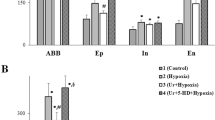Summary
In this study evidence is provided to suggest that nucleoside formation with hypoxia in myocardial tissue from the guinea-pig follows a different course from that in the rat, rabbit or dog. 1) After ischemia, tissue levels of adenosine remain barcly detectable in the guinea-pig but rise considerably in the rat and the dog. 2) IMP, remaining almost absent in the dog, does not change in the rat but strongly increases (×6) in the guinea-pig heart with ischemia. 3) Mioflazine, a nucleoside transport inhibitor, completely reverses the ratio adenosine/inosine in dog myocardium after 8 min of ischemia, making adenosine by far the major nuclcoside. No effect could be detected in the guinea-pig. 4) In contrast with the rat and rabbit, ischemia in the guinea-pig does not lead to any considerable release of adenosine upon reperfusion. 5) In the rabbit, the presence of a nucleoside transport inhibitor completely reverses the adenosine/inosine ratio in reperfusates after ischemia. Although the release is strongly inhibited under these conditions in the guinea-pig, adenosine release remains negligible when compared with inosine. 6) Even in the presence of high concentrations of an adenosine deaminase inhibitor, inosine remains the major metabolite released upon reperfusion after ischemia, in the guinea-pig heart.
Similar content being viewed by others
References
Berne RM, Rubio R (1974) Adenine nucleotide metabolism in the heart. Circ Res 34 (Suppl III): 109–118
Flameng W, Xhonneux R, Van Belle H, Borgers M, Van de Water A, Wynants J, Wouters L, Thoné F, Van Daele P, Janssen PAJ (1984) Cardioprotective effects of mioflazine during one hour of normothermic global ischemia in the canine heart. Cardiovasc Res 18:528–537
Wynants J, Van Belle H (1985) Single-run high-performance liquid chromatography of nucleotides, nucleosides and major purine bases and its application to different tissue extracts. Anal Biochem 144:258–266
Schrader J, Gerlach E (1976) Compartmentation of cardiac adenine nucleotides and formation of adenosine. Pflügers Arch 367:129–135
Kolassa N, Pfleger K (1975) Adenosine uptake by erythrocytes of man, rat and guinea pig and its inhibition by hexobendine and dipyridamole. Biochem Pharmacol 24:154–156
Rosenberger LB, Jacobs LW, Stanton HC (1984) Evaluation of cardiac anoxia and ischemia models in the rat using calcium antagonists. Life Sci 34:1379–1387
Geisbuhler T, Altschuld RA, Trewyn RW, Ansel AZ, Lamka K, Brierley GP (1984) Adenine nucleotide metabolism and compartmentalization in isolated adult rat heart cells. Circ Res 54:536–546
Gerlach E, Deuticke B (1966) Vergleichende Untersuchungen über die Bildung von Adenosin in Myokard verschiedener Tierspecies bei Sauerstoffmangel. Klin Wschr 22:1307–1310
Fredholm BB, Hedqvist P, Lindström K, Wennmalm M (1982) Release of nucleosides and nucleotides from the rabbit heart by sympathetic nerve stimulation. Acta Physiol Scand 116:285–295
Rothaul AL, Broadley KJ (1981) Use of hexobendine to examine whether the coronary vasodilator metabolite released from guinea pig isolated hearts is adenosine. Cardiovascular Res 15:599–610
Agarwal RP, Spector T, Parks RE (1977) Tight-binding inhibitors. IV. Inhibition of adenosine deaminases by various inhibitors. Biochem Pharmacol 26:359–367
Henderson JF, Brox L, Zowbor G, Hunting D, Lomax CA (1977) Specificity of adenosine deaminase inhibitors. Biochem Pharmacol 26:1967–1972
Author information
Authors and Affiliations
Rights and permissions
About this article
Cite this article
Van Belle, H., Wynants, J. & Goossens, F. Formation and release of nucleosides in the ischemic myocardium. Is the guinea-pig the exception?. Basic Res Cardiol 80, 653–660 (1985). https://doi.org/10.1007/BF01907864
Received:
Issue Date:
DOI: https://doi.org/10.1007/BF01907864




